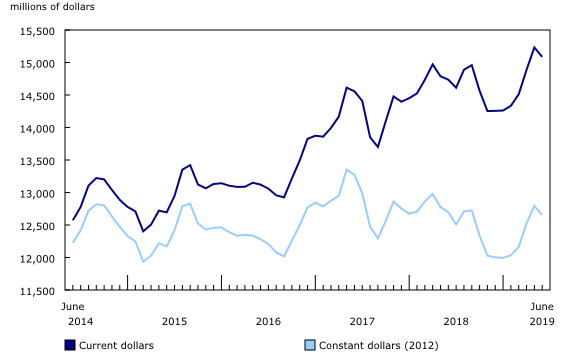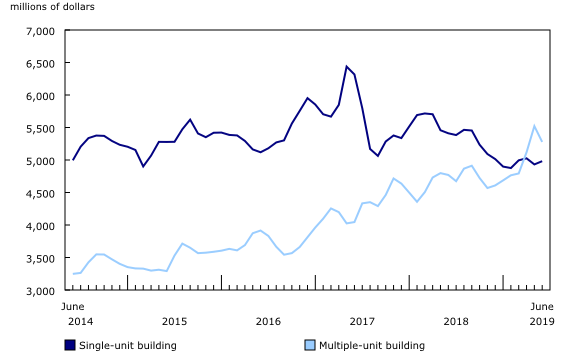Investment in building construction, June 2019
Archived Content
Information identified as archived is provided for reference, research or recordkeeping purposes. It is not subject to the Government of Canada Web Standards and has not been altered or updated since it was archived. Please "contact us" to request a format other than those available.
Released: 2019-08-21
$15.1 billion
June 2019
0.9% 
(monthly change)
Total investment in building construction decreased 0.9% in June to $15.1 billion, the first decline in eight months. A slight increase in non-residential investment (+1.0% to $4.8 billion) was offset by a decrease in the residential sector (-1.8% to $10.3 billion). On a constant dollar basis (2012=100), investment in building construction decreased 1.1% to $12.7 billion. Despite the monthly decrease, total investment grew 1.6% year over year in the second quarter.
For more information on housing, please visit the new Housing Statistics Portal.
Decline in multi-unit investments
Investment in multi-unit dwellings declined for the first time in eight months, down 4.4% to $5.3 billion, while investment in single-unit construction increased 1.0% to $5.0 billion. The decrease in total residential investment stemmed mainly from declines in British Columbia (-$174.1 million) and Manitoba (-$54.0 million).
Non-residential investment
Non-residential investment increased in seven provinces, led by British Columbia (+$27.4 million). This growth more than offset the declines in Newfoundland and Labrador, Prince Edward Island and New Brunswick.
All three components in the non-residential sector posted gains. The institutional component had the largest increase (+1.4% to $1.1 billion), which was due to projects such as the new Calgary Cancer Centre. The commercial component advanced 0.9% to $2.8 billion, while investment in the industrial component increased 0.7% to $911.1 million.
Second quarter 2019
Total investment in building construction grew 1.6% (+$710.7 million) in the second quarter, compared with the same quarter a year earlier. The gain was driven by multi-dwelling investments in British Columbia (+36.6%) and Ontario (+20.6%). By contrast, investment in single-unit dwellings decreased 9.9%, compared with the second quarter of 2018.
For non-residential investments, the institutional component was the only component to post a decrease (-6.9%), with the largest declines observed in Alberta (-21.3%) and Ontario (-13.0%).
On an unadjusted basis, quarterly investment in new non-residential construction remained strong—increasing 9.4% year over year to $6.5 billion. This increase reflects gains in the commercial component (+$517.5 million)
Investment in new residential construction was down 4.3%, compared with the second quarter of 2018, to $13.3 billion, as a result of decreases in single-family homes (-22.1%) and semi-detached homes (-14.6%). However, this was moderated by investment gains in row homes (+14.0%) and apartments (+11.5%).
Note to readers
Unadjusted data for the current reference month are subject to revision as a result of late responses. Data for the previous month have been revised. Seasonally adjusted data are revised for the previous two months.
Data presented in this release are seasonally adjusted and are expressed in current dollars unless otherwise stated. Using seasonally adjusted data facilitates month-to-month comparisons by removing the effects of seasonal variations. For information on seasonal adjustment, see Seasonally adjusted data – Frequently asked questions.
Monthly estimates for constant dollars are calculated using quarterly deflators from the Building Construction Price Index (table 18-10-0135-01). Typically, the first two months of a quarter use the previous quarter's price level and are revised when the new quarterly price index becomes available.
Detailed data on investment activity by type of building and type of work are now available in the unadjusted current dollar series.
As a result of data source constraints, the total value for "type of work – all" may not equal the sum of its parts ("new construction," "renovation," "conversion," and "other"). The component required to complete the summation is "type of structure, minor."
In the type of work series "conversions total," one or more residential dwelling units are created from an existing structure. Deconversions, garages and carports, as well as in-ground swimming pools, are grouped together in the "other types of work" category.
Prior to January 2018, building permits for cottages with a value greater than $60,000 were automatically reclassified to structure type "single." Beginning with January 2018, regardless of value, building permits received from municipalities coded as cottages remain classified as cottages.
Effective November 23, 2018, table 34-10-0175-01 contains data on both the residential and non-residential sector. It replaced tables 34-10-0010-01, 34-10-0011-01 and 34-10-0012-01.
Next release
Data on investment in building construction for July will be released on September 23.
Products
Statistics Canada has a new Housing Market Indicators Dashboard. This web application provides access to key housing market indicators for Canada, by province and by census metropolitan area. These indicators are automatically updated with new information from monthly releases, giving users access to the latest data.
Contact information
For more information, or to enquire about the concepts, methods or data quality of this release, contact us (toll-free 1-800-263-1136; 514-283-8300; STATCAN.infostats-infostats.STATCAN@canada.ca) or Media Relations (613-951-4636; STATCAN.mediahotline-ligneinfomedias.STATCAN@canada.ca).
- Date modified:






